1. Transcription sets the stage for Translation
As you’ve learned in previous tutorials, the central dogma of molecular genetics is DNA makes RNA makes protein.
When cells make protein, they transfer information from a sequence of nucleotides into a sequence of amino acids. If you think about nucleic acids (written in nucleotides) and protein (written in amino acids) as different languages, then protein synthesis is a shift in molecular language. As a result, protein synthesis is called translation.
During transcription, the phase preceding protein synthesis, the cell creates the various types of RNA that make protein synthesis possible. To review the big picture of transcription and translation, label this diagram.
[qwiz qrecord_id=”sciencemusicvideosMeister1961-Transcription/Translation Interactive Diagram”]
[h]Transcription and translation
[q labels = “top”]
[l]DNA
[fx] No. Please try again.
[f*] Great!
[l]cell membrane
[fx] No. Please try again.
[f*] Good!
[l]nuclear membrane
[fx] No, that’s not correct. Please try again.
[f*] Excellent!
[l]cytoplasm
[fx] No. Please try again.
[f*] Correct!
[l]mRNA
[fx] No, that’s not correct. Please try again.
[f*] Excellent!
[l]tRNA
[fx] No. Please try again.
[f*] Correct!
[l]RNA
[fx] No. Please try again.
[f*] Correct!
[l]nuclear pore
[fx] No, that’s not correct. Please try again.
[f*] Great!
[l]protein
[fx] No. Please try again.
[f*] Great!
[l]ribosome/rRNA
[fx] No. Please try again.
[f*] Good!
[l]transcription
[fx] No, that’s not correct. Please try again.
[f*] Correct!
[/qwiz]
Note the function of each type of RNA:
- mRNA/messenger RNA (11) is a molecular message that specifies the sequence of amino acids in a protein (9).
- rRNA/ribosomal RNA, along with protein, is what makes up the ribosome (10). Think of ribosomes as “protein factories” that can make any kind of protein.
- tRNA/transfer RNA (8) brings amino acids to the ribosome.
Continue reading to learn more about each of the key players in translation.
2. Making protein is the goal of translation
Proteins are the action molecules of cells and organisms. Most of life’s key functions (like movement, defense, or enzymatic control of chemical reactions) are based on proteins. What you’ll see as we move through this course is that life is a system of genes (made of nucleic acids) that specify proteins, which reproduce those genes.
In a previous module in this course, you’ve already learned about the chemistry of proteins. Here’s a quick review of the basics. If you find, as you read what’s below, that you feel hazy on what we learned earlier this year, definitely go back to review (access the tutorials through the main menu above), and then come back here.
1. Proteins are polymers of amino acids. As shown below, each amino acid consists of a central carbon atom. The central carbon is bonded to an amino group (—NH2) on one side, a carboxylic acid group (—COOH) on the other side, and a side chain (also known as an “R-group”). The side chains vary in their composition and chemistry and can be polar/hydrophilic, non-polar/hydrophobic, acidic, or basic.
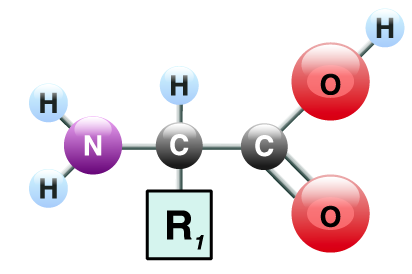
2. There are 20 amino acids. You can think of them as an alphabet. In the same way that English uses the 26 letters of the alphabet to create hundreds of thousands of words, cells use various combinations of amino acids to create hundreds of thousands of proteins. As a result, proteins are the most diverse macromolecule.
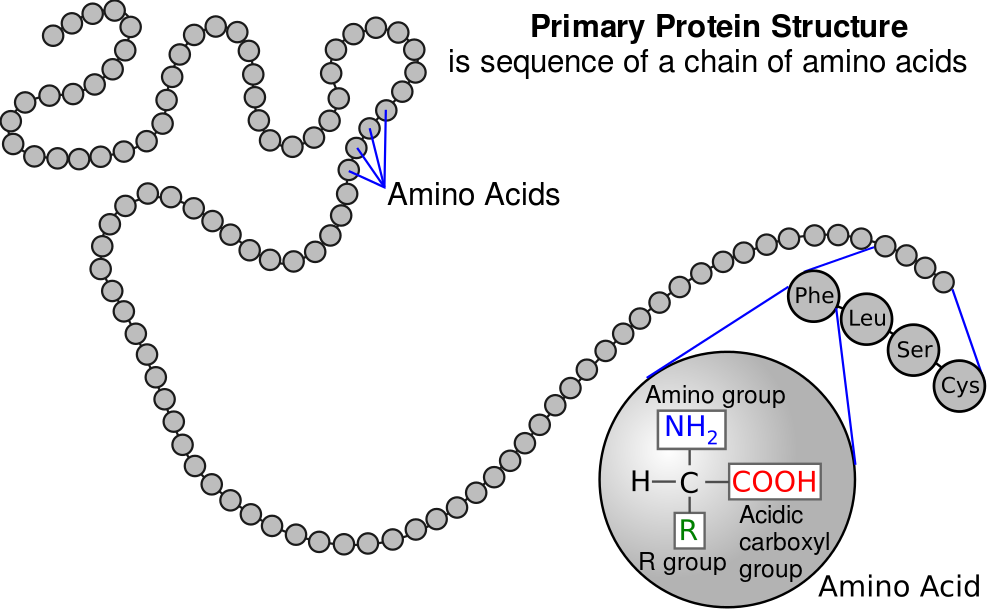
3. In diagrams about proteins and protein synthesis, amino acids are represented by three-letter abbreviations. In what’s above, Phe represents the amino acid phenylalanine, leu represents leucine, and so on.
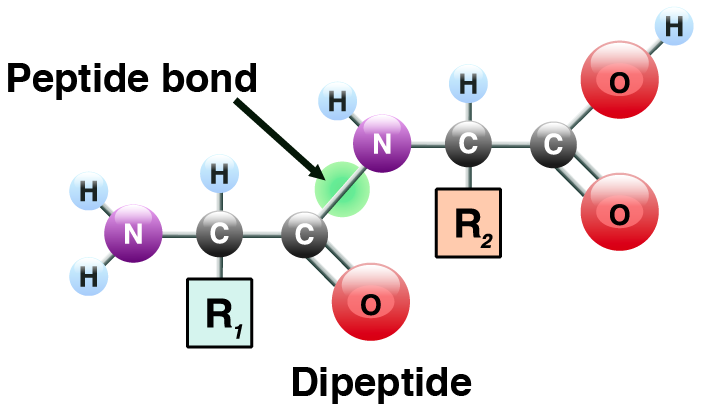
4. Amino acids in proteins are joined by peptide bonds (find the bond indicated by the green circle above).
5. Two linked amino acids form a dipeptide (see above).
6. A chain of amino acids that are linked together is known as a polypeptide. A polypeptide can as short as a few amino acids, or hundreds of amino acids long.
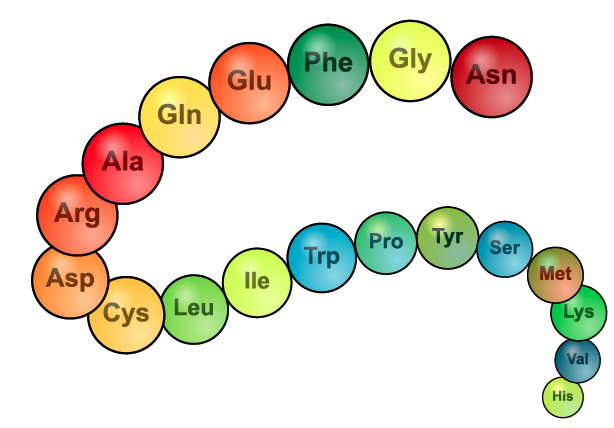
7. Interactions between amino acids cause a polypeptide to fold into a specific shape. This leads to the notion of levels of protein structure.
- Primary structure is the genetically determined, linear sequence of amino acids in a polypeptide chain.
- Secondary structure results from hydrogen bonds that form between carbonyl and hydroxyl groups within the polypeptide backbone. This results in alpha helices (think of a corkscrew), or beta-pleated sheets (think of a piece of paper with many parallel folds).
- Tertiary structure results from interactions between amino acid side chains, resulting in complex turns and loops.
- Quaternary (4th-level) structure results from interactions between separate polypeptide chains.
8. The shape that emerges from these interactions determines a protein’s function. For example, the enzyme shown below will only be able to interact with its substrate if it has a specific shape.
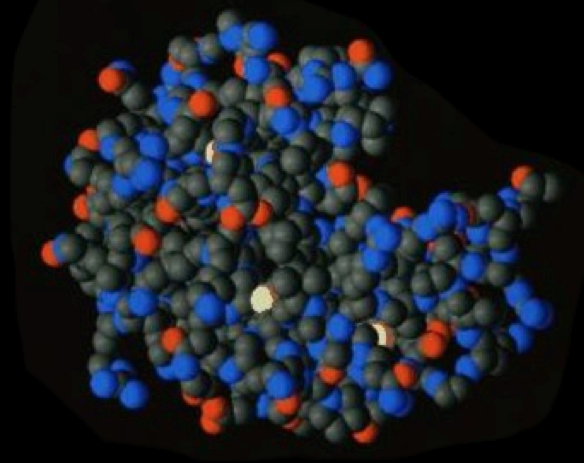
3. Protein Chemistry Review Quiz
[qwiz random = “true” use_dataset=”SMV_Protein Synthesis_protein chemistry review” dataset_intro=”true” qrecord_id=”sciencemusicvideosMeister1961-Protein Chemistry Review Quiz (M14)”][h]
Review Quiz: Protein Chemistry and Structure
[i]This quiz includes many of the details about protein structure you learned about in module 6.
[x][restart]
[/qwiz]
4. Messenger RNA (mRNA) codes for proteins
Here’s what you need to know about messenger RNA:
- mRNA is a polymer of RNA nucleotides.
- mRNA’s function is to specify the order of amino acids in a protein. Note that if you need to review how the genetic code works, you can do so in the previous tutorial.
- Within the coding portion of mRNA, every three nucleotides make up a codon.
- Each codon codes for one amino acid.

- Some codons serve as punctuation. The codon “AUG,” for example, signals the start of a polypeptide chain. Three other codons indicate the chain’s end.
5. Transfer RNAs (tRNAs) bring amino acids to the ribosome.
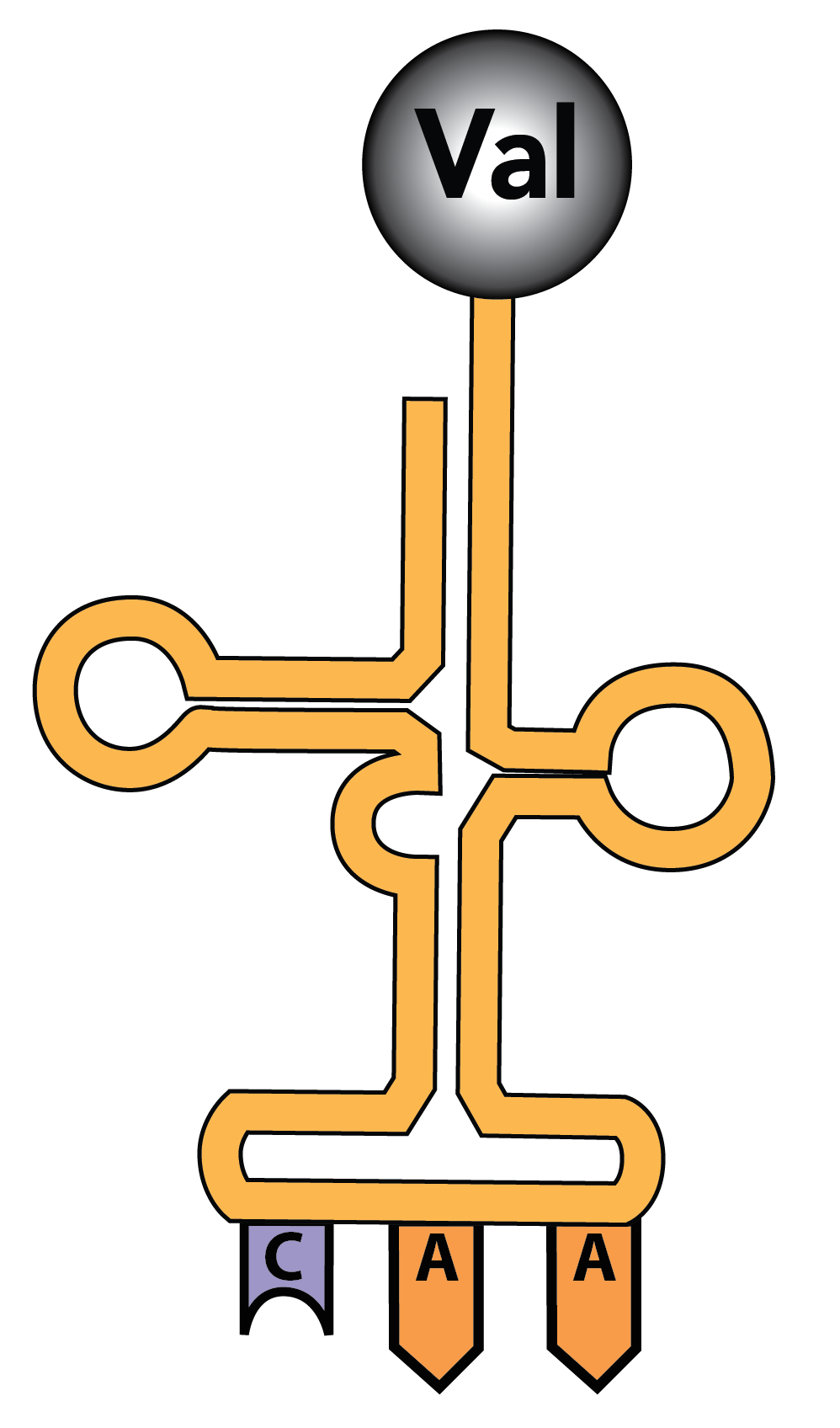
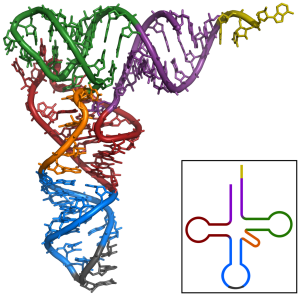
tRNAs are also RNA polymers. They’re generally between 75 and 90 RNA nucleotides long. But unlike mRNAs, which are linear, hydrogen bonding between nucleotides within a tRNA causes it to fold up. The resulting shape is often represented as a type of cloverleaf, as shown on left. A more realistic model (showing some of the base pairing between complementary nucleotides) is shown on the right.
On the bottom of the tRNA is an anti-codon: 3 RNA nucleotides that complement the codons in RNA
The top of the tRNA has an amino acid binding site.
There are about 45 distinct tRNAs. Each one has a distinct anti-codon. Since there are only 20 amino acids, several of the tRNAs carry the same amino acid (which is the basis for the fact that many codons are synonymous, coding for the same amino acid).
6. Ribosomes are general-purpose protein factories
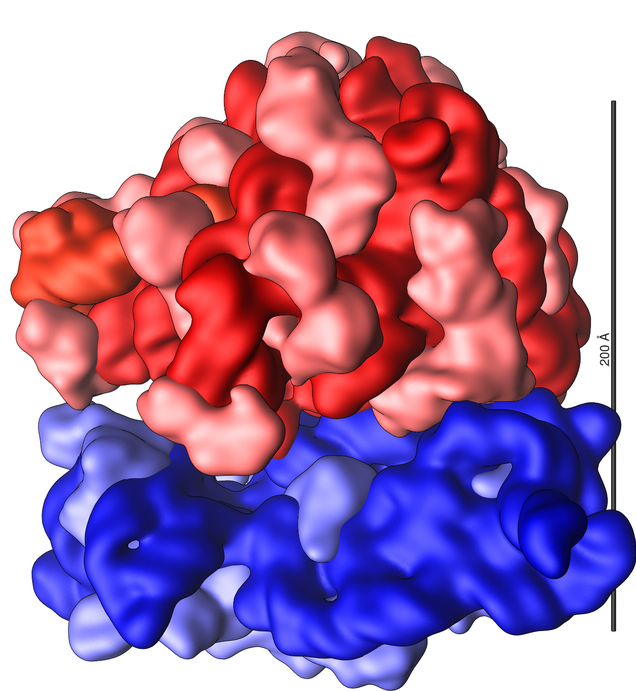
Ribosomes are made of ribosomal RNA (rRNA), along with dozens of proteins.
In terms of function, ribosomes are protein factories capable of reading mRNA instructions and, with the help of tRNAs, assembling any protein the cell needs to make.
In prokaryotic cells, ribosomes are found floating freely in the cytoplasm. In eukaryotic cells, they can be in the cytoplasm, or attached to the endoplasmic reticulum (creating the rough E.R.). Chloroplasts and mitochondria also have their own ribosomes, another remnant of their prokaryotic evolutionary origins.
The ribosome is made of two subunits that attach during the process of protein 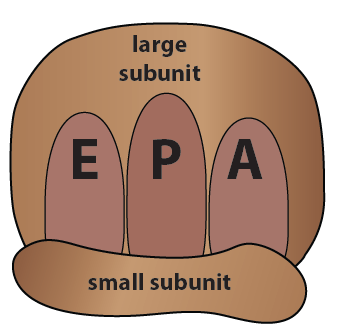 synthesis, then detach after the process is finished. In the image above left, the small subunit is shown in blue, and the large subunit in red. RNA is shown in dark blue and dark red. The lighter shades of blue and red represent proteins.
synthesis, then detach after the process is finished. In the image above left, the small subunit is shown in blue, and the large subunit in red. RNA is shown in dark blue and dark red. The lighter shades of blue and red represent proteins.
In the explanation of the protein synthesis that follows, we’re going to use the image on the right. “E”, “P,” and “A” are binding sites, as I’ll explain below.
7. An overview of translation
During translation, ribosomes “read” the mRNA, translating the sequence of codons in the mRNA into a sequence of amino acids in a protein.

The diagram above shows translation in progress. You’ll watch an animation of this process in a moment, but, for now, notice these key aspects of the process.
- The ribosome is wrapped around the mRNA in a way that exposes the mRNA codons to the cytoplasm.
- The tRNA in the “P” site is holding on to the growing polypeptide, which now consists of three amino acids.
- The tRNA in the “A” site has just entered the ribosome. It’s temporarily held in place by hydrogen bonds between the tRNA’s anticodon and the mRNA’s codon. Imagine that before this tRNA became temporarily stuck, dozens of other tRNAs might have bumped into the “A” site. But because their anti-codon didn’t complement the mRNA codon, each one bounced away.
- What’s the next move? With the correct tRNA in place, the ribosome acts like an enzyme and binds the amino acid in the “A” site to the polypeptide in the “P” site.
Here’s a summary of the three ribosomal binding sites
- The “E” site is the exit site. After a tRNA has “donated” its amino acid to the growing polypeptide, it moves to the E site, and then leaves the ribosome.
- The “P” site is where the ribosome holds onto the growing protein. It’s formally known as the peptidyl-tRNA site.
- The “A” site is where new tRNAs enter the ribosome. Its formal name is the “amino-acyl tRNA site”
8. Protein Synthesis Music Video
Pretty much everything you need to know about protein synthesis at the introductory college/AP Biology Level is found in my protein synthesis music video. Strap yourself in, because my music partner Max Cowan gives this a heavy metal sound. If you’re in a classroom or a computer lab with other students within earshot, please use your headphones/earbuds.
9. Protein Synthesis: Interactive Lyrics
Warning! It takes me about 7 minutes to complete this quiz…so it’s probably going to take you longer. But you will learn a ton by doing it! If you don’t finish you can come back and do only the questions you haven’t done; look for the option “New” after you click “Start quiz”.
[qwiz style = “border: 3px solid black;” dataset_intro=”true” random=”false” qrecord_id=”sciencemusicvideosMeister1961-Protein Synthesis Interactive Lyrics (M14)” use_dataset=”SMV_protein_synthesis_interactive_lyrics2″]
[h] Protein Synthesis: Interactive Lyrics
[i]
|
[/qwiz]
10. Protein Synthesis/Translation Flashcards
[qdeck use_dataset=”Protein_synthesis_FC-DS,v2″ random = “true” dataset_intro=”true” display_name=”Protein Synthesis Flashcards” qrecord_id=”sciencemusicvideosMeister1961-Protein Synthesis/Translation Flashcards (M14)”]
[h]Protein Synthesis Flashcards
[i]
[x][restart]
[/qdeck]
11. Protein Synthesis/Translation Quiz
[qwiz use_dataset=”Protein_synth_MC, HM, ID (AP-DS)” random = “true” dataset_intro = “true” display_name=”Protein Synthesis” qrecord_id=”sciencemusicvideosMeister1961-Protein Synthesis/Translation Quiz (M14)”]
[h]Protein Synthesis/Translation Quiz
[i]This quiz has 65 questions. If you need to stop and then come back later to finish, look for an option to only do questions you haven’t already done (“New”) after you click ‘Start quiz'”
[x][restart]
[/qwiz]
Next moves
- How Proteins are Targeted to the Rough ER (the last tutorial in this series)
- From Gene to Protein Menu

